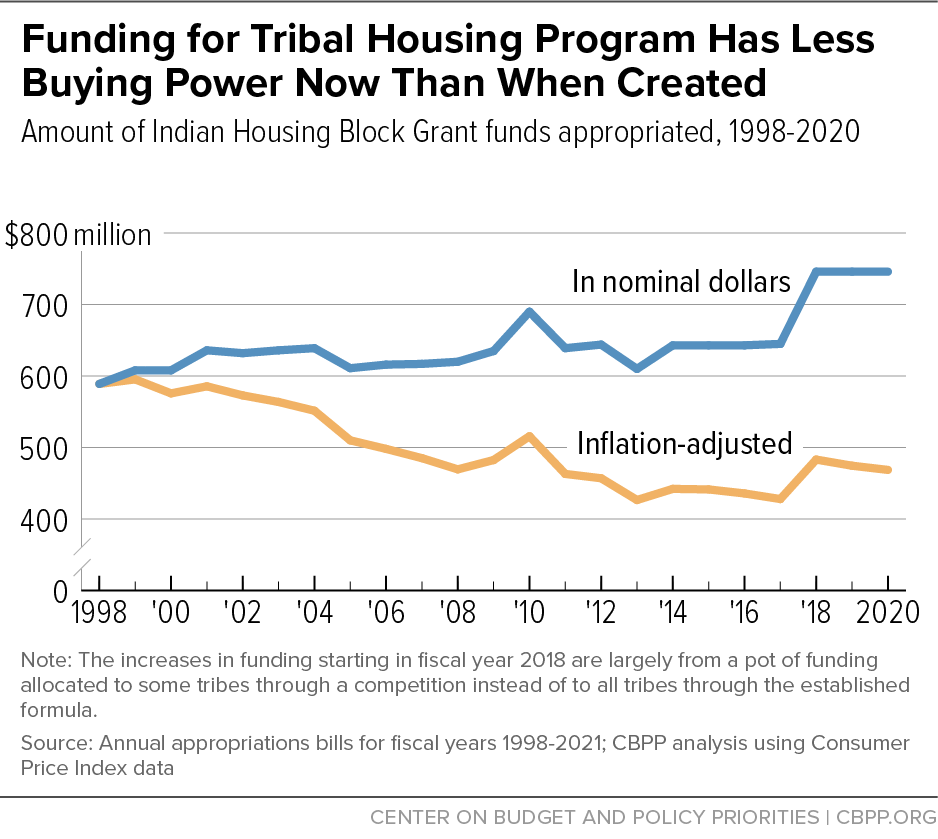BEYOND THE NUMBERS
Build Back Better would provide $1 billion in critical funding to develop housing and make it more affordable for tribal nations and Native Hawaiians. Due to policies of forced displacement and relocation and disenfranchisement, nearly 1 in 4 American Indians and Alaska Natives lives in poverty. Build Back Better’s additional resources would help address the issues specific to those living in tribal areas, such as higher rates of overcrowding and substandard housing.
As a way to respect sovereignty, tribal governments get federal housing funding through separate Department of Housing and Urban Development (HUD) grants, instead of through programs such as Housing Choice Vouchers, public housing, or the HOME Investment Partnerships Program. Under a 1996 law, tribal governments (or tribally designated housing entities) receive a flexible pot of funding known as the Indian Housing Block Grant (IHBG) or Native American Housing Block Grant (NAHBG), which they can use for affordable housing initiatives that serve American Indians and Alaska Natives with low incomes, and in some cases non-Native residents, who live in tribal areas (such as reservations, pueblos, and Alaska Native villages). Congress created the similar Native Hawaiian Housing Block Grant in 2000.
While housing hardship varies by location, tribal areas face high rates of substandard housing conditions, such as a lack of plumbing or heating. And the average rate in 2019 of overcrowding (defined as more than one person per room) for American Indians and Alaska Natives living on tribal lands was 13 percent, well above the national average of 3.3 percent. Some Alaska Native villages had such rates above 50 percent. While exact data are limited because HUD’s homelessness counts generally do not include tribal lands, research shows that people on many reservations experience homelessness not by sleeping in the streets or in shelters but by living doubled or tripled up. Just like with homelessness, the high rates of overcrowding stem from a lack of quality affordable homes.
Some 68,000 new homes are needed to eliminate overcrowding and replace inadequate housing across Indian Country, that same research shows. These data were collected 2013–2015, and a rise in the population of American Indians and Alaska Natives living in and around tribal areas has likely made these home shortages worse. And many tribes, particularly ones in remote areas, face infrastructure barriers that have led to more homes lacking complete plumbing or heating or having other physical problems.
Funding for tribal housing development and assistance programs, however, has remained relatively flat since the 1996 enactment of the tribal housing law. Annual IHBG appropriations haven’t kept pace with inflation, although Congress has provided some helpful increases in the past few years. (See graphic.)
That’s why Build Back Better’s tribal housing investments are critical. They will help make up for the decrease in purchasing power over the years and will help tribes build desperately needed new housing, repair existing homes, and continue important rental and homeownership assistance programs. The bill would provide a total of $555 million for IHBG: half to be allocated through the regular IHBG formula and the other half through a competitive process. It would also provide $200 million for the Indian Community Development Block Grant, which can be used for housing, community facilities, and economic development.
Build Back Better would provide the Native Hawaiian Housing Block Grant with another $200 million, a major increase over the program’s $2 million in each fiscal year from 2017 through 2021. The money would go directly to helping eligible Native Hawaiians with low incomes live on their homelands. Eligibility to live on the Hawaiian homelands isn’t based on income, but on average, those waiting for a home or lot have lower incomes and face more significant housing problems than Native Hawaiian households overall.
Other housing programs such as the Low-Income Housing Tax Credit and the National Housing Trust Fund would also receive additional resources under Build Back Better, which states could use to build or rehabilitate housing on tribal lands. But these state-level allocations would mean projects on reservations would compete with those in the rest of the state, under programs not designed to address land-use barriers specific to tribal areas. Build Back Better’s dedicated housing funding would ensure tribes can access needed resources and is a necessary component of the U.S. government’s responsibilities to these nations.

